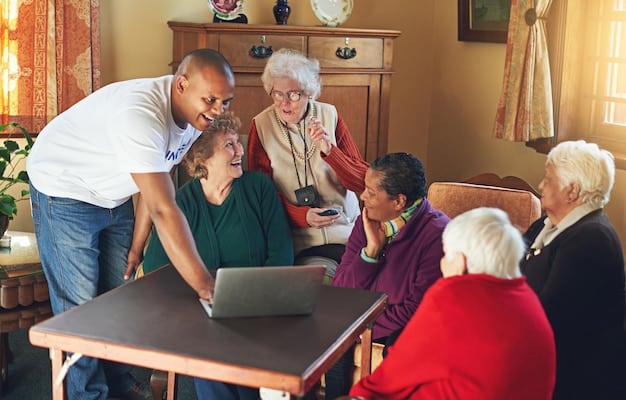Respite Care Options: A 2025 Guide for US Caregivers

Respite care options in 2025 encompass a variety of short-term care services designed to provide temporary relief for primary caregivers in the US, ranging from in-home assistance and adult day care to residential facilities, ensuring both caregivers and care recipients receive essential support.
Being a caregiver is a demanding job, and it’s crucial to remember that even superheroes need a break. That’s where respite care options: A comprehensive guide for US caregivers in 2025 come in, serving as a lifeline for those providing constant care to loved ones, and allow you to recharge and avoid burnout.
Understanding Respite Care for US Caregivers
Respite care is temporary care for an individual who is sick, elderly, or has special needs. It provides caregivers with a much-needed break from their duties, allowing them to attend to their own needs and well-being.
It’s designed to support the well-being of both primary caregiver and the person receiving care.
Why Respite Care Matters
Caregiving can be incredibly stressful and isolating. Respite care offers a temporary relief, allowing caregivers to rest, run errands, attend appointments, or simply engage in activities they enjoy.
- Prevents caregiver burnout
- Improves mental and physical health
- Strengthens the caregiver-care recipient relationship
- Allows caregivers to maintain their own lives
Ignoring the needs of caregivers can lead to exhaustion, depression, and a decline in the quality of care provided. Recognize the need of respite, it’s not a sign of weakness but strength.

In conclusion, respite care is a fundamental support system for caregivers, positively impacting their health and their capacity to provide quality care. By understanding its importance, caregivers can take steps to ensuring long term well-being.
Types of Respite Care Services Available in the US in 2025
Now let’s delve into the array of respite care services available across the US. The goal here is to find the perfect fit for the person in your care and for your individual needs.
The options range from in-home support to specialized facilities, each offering unique benefits.
In-Home Respite Care
In-home respite care involves a professional caregiver coming to the home to provide assistance. This option allows individuals to remain in their familiar surroundings while receiving care. It enables the caregiver to go run errands, or just have a break.
Adult Day Care Centers
Adult day care centers offer a structured environment where individuals can socialize, participate in activities, and receive supervision during the day. This option is ideal for those who need social interaction and stimulation.
- Social interaction and recreation
- Supervision and assistance with daily activities
- Nutritious meals and snacks
- Therapeutic activities and exercise programs
The multitude of respite options are designed to accommodate everyone’s preferences, from in-home care allowing for personal interaction, to community centers.
Many factors need to be considered, but it’s important to know the available options and decide what suits you best.
Finding Respite Care in Your Community
Finding the right respite care provider involves research, networking, and leveraging available resources. Your local community is a great place to start when searching for suitable options.
Local support groups, community centers, and online databases can provide valuable information and referrals.
Resources for Finding Local Respite Care
Several organizations and websites specialize in connecting caregivers with respite care services. These resources can help you identify providers in your area, compare services, and assess quality.
- The ARCH National Respite Network and Resource Center
- Eldercare Locator
- Area Agencies on Aging
Connecting with local resources is an important aspect of care, don’t be afraid to interact and reach out to the communities.

Building a network increases the chances of finding a provider, as well as creating an enriching community for all involved.
Paying for Respite Care: Financial Assistance Options
Paying for respite care is a real concern for many families. Knowing the public and private funding may relieve some of the burden involved.
Several financial assistance programs are available to help offset the costs associated with respite care. These options can make respite care more accessible and affordable.
Government Programs and Insurance Coverage
Explore government programs like Medicaid and Veteran’s Affairs benefits, as well as private insurance policies that may cover respite care services. Eligibility requirements and coverage levels vary, so it’s essential to research your options thoroughly.
These include:
- Medicaid Waivers
- Veteran’s Affairs (VA) Benefits
- Private Insurance Policies
Investigating all potential routes of payment, from social care to personal finances, may provide the possibility of easing the financial issues of care.
Integrating Respite Care Into Your Caregiving Routine
Implementing respite care efficiently requires planning, communication, and flexibility. It’s essential to develop a strategy that meets the needs of both the caregiver and the care recipient.
Start by assessing your needs, identifying potential providers, and establishing a regular respite schedule.
Tips for a Successful Respite Care Experience
To make the most of respite care, communicate openly with the respite provider, prepare clear instructions, and create a welcoming environment for the care recipient.
Consider the following aspects in the integration process:
- Open Communication with the Respite Provider
- Clear Instructions and Expectations
- Creating a Welcoming Environment
When respite is integrated with careful consideration, it becomes a key component of the maintenance process, promoting the well-being of everyone involved.
The Future of Respite Care in the US: Trends and Predictions for 2025
What will respite care look like in the near future? Numerous ongoing developments, like technological advances to policy shifts, influence the way care is provided and accessed.
Changes can affect various facets of care, from the way people are cared for, to how services are accessed.
Technological Advances and Innovative Solutions
Telehealth, remote monitoring devices, and other technologies will play an increasingly important role in respite care. These tools can enhance care coordination, improve access to services, and provide peace of mind for caregivers.
Technological improvements can assist in:
- Telehealth and Remote Monitoring
- Care Coordination Apps
- Wearable Devices for Safety
Looking towards the future of respite care requires keeping up to date with new technologies, being ready for changes in policy and embracing these tools.
| Key Aspect | Brief Description |
|---|---|
| 🏡 In-Home Care | Caregivers provide assistance at home, offering familiar comfort. |
| 🧑⚕️ Adult Day Centers | Structured environments for socializing and activities during the day. |
| 💰 Financial Aid | Explore government programs and insurance for respite care costs. |
| 🤖 Tech Integration | Telehealth and monitoring devices enhance care coordination. |
Frequently Asked Questions About Respite Care
▼
Respite care is temporary care for someone who requires it due to illness, old age or disabilities. It is basically short term solution designed to provide relief for caregivers.
▼
To locate respite care in your area, start by checking with local hospitals, senior centers, and caregiver support organizations, as well as searching the ARCH National Respite Network.
▼
Respite care costs vary widely depending on the type of care, location, and duration. Home care can range from $20 to $40 per hour, whereas adult day care is often cheaper.
▼
Yes, several financial assistance options exist, including Medicaid, Veteran’s benefits, and private insurance. Eligibility requirements and coverage vary, so it is important to research specific needs.
▼
When selecting a provider, consider their qualifications, experience, and references. Ensure their approach aligns with the care recipient’s needs. Always check reviews and licenses to give you peace of mind.
Conclusion
In conclusion, understanding and utilizing respite care options is crucial for US caregivers in 2025. By exploring the various types of respite care, finding resources in your community, understanding payment options, and planning for the future, caregivers can ensure they receive the support they need to continue providing quality care while maintaining their own well-being.





